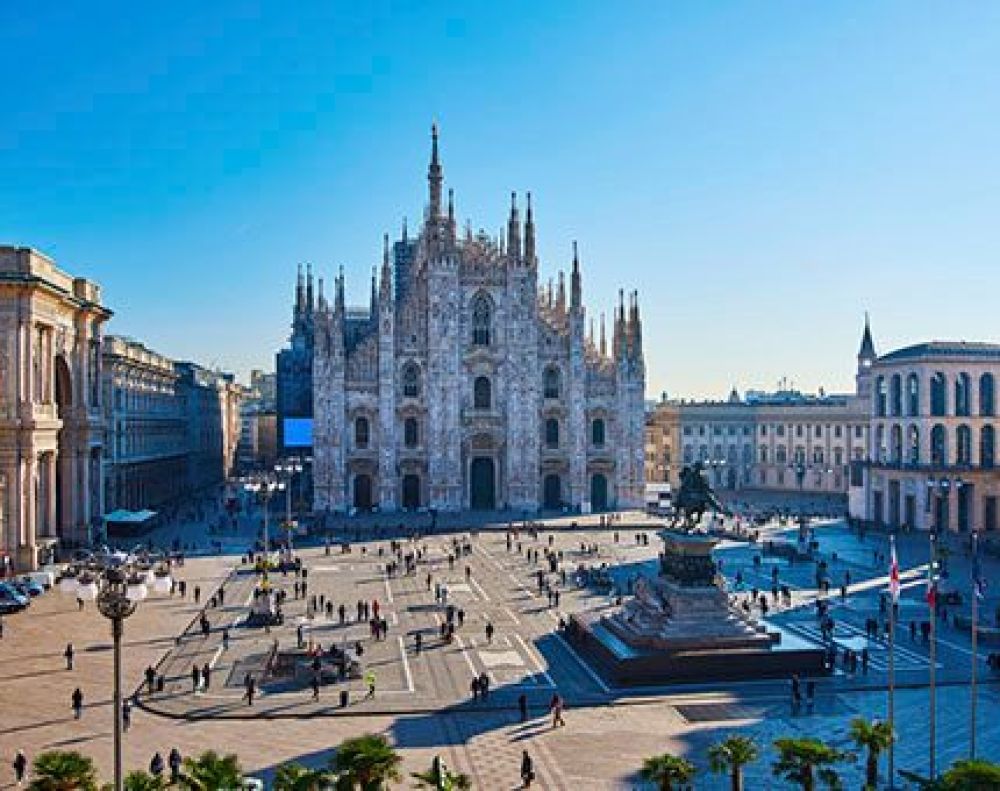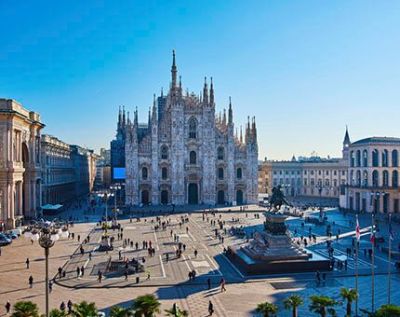

The Duomo di Milano stands as a magnificent gothic cathedral and is perhaps the most iconic building in Milan. Embark on a guided tour of this architectural marvel and learn about its extensive history, art, and religious significance. The cathedral, which took nearly six centuries to complete, boasts impressive facades, intricate spires, and an awe-inspiring interior adorned with stained-glass windows and sculptures. Visitors can also access the roof, where they can enjoy panoramic views of the city and a closer look at the spire which holds the famous golden statue of the Madonna, the symbol of Milan. The guided tour often includes access to the Duomo Museum and the Church of St. Gottardo in Corte, which together provide a deeper understanding of this site's spiritual and cultural importance.
The Galleria Vittorio Emanuele II, one of the world's oldest shopping malls, is housed within a four-story double arcade in central Milan. Named after Victor Emmanuel II, the first king of the Kingdom of Italy, this structure is a prime example of Italian elegance and style. Marvel at the impressive architecture with a soaring glass dome, rich frescoes, and mosaic floors, as you explore a multitude of shops ranging from luxury brands to authentic Italian restaurants and historic cafes. Though you're here to shop or dine, the ambiance of the Galleria is an attraction in itself, making it a fantastic location for photographers and architecture enthusiasts. The Galleria is not only a hub for commerce but also a symbolic center of Milanese social life.
The rooftop terraces of the Duomo offer an unforgettable experience, providing a unique vantage point from which to admire the skyline of Milan. Walking along the terraces, visitors can gaze upon the elaborate sculptures and spires up close, including a view of the Madonnina, a statue of the Virgin Mary covered in gold leaf. This tour is particularly popular at sunset when the city is bathed in a golden light, offering a romantic and breathtaking scene. Safety is ensured with secure pathways and railings so visitors of all ages can enjoy the view. Many find this peaceful and surreal perspective of the city to be the highlight of their Milan visit.
The iconic Teatro alla Scala, or La Scala, is one of the most famous opera houses in the world. Your visit to La Scala includes more than just the chance to see a performance; it's an immersive journey into the history of theatre and music. Inside, the La Scala Museum hosts a collection of instruments, costumes, portraits, and set designs that narrate centuries of operatic and theatrical history. Moreover, a guided tour typically allows you to peek inside the auditorium, the orchestra pit, the royal box, and the stage itself. Even without a performance, the grandeur of La Scala will leave you captivated, providing insight into the world-class productions that have graced its stage.
Exploring Piazza del Duomo through a walking tour gives visitors an intimate look at the cultural heart of Milan. The square is not only home to the Cathedral but also hosts a series of important historic buildings, including the Royal Palace of Milan and the Galleria Vittorio Emanuele II. As you stroll around, a knowledgeable guide will share stories and anecdotes that bring the history of these sites alive. While the square is always bustling, a guided tour provides context and significance to the landmarks, complete with talks on the architecture and sculptures that adorn the buildings. It's a history lesson amidst the beauty of Milan's central square.
Below the surface of the Duomo lies the Crypt of St. Charles, a less-visited but deeply historical part of the cathedral complex. Visitors on this guided tour will descend into the Crypt, which serves as the final resting place of Saint Charles Borromeo, the Archbishop of Milan from 1564 to 1584. His remains are displayed in an ornate crystal casket, set against the backdrop of the crypt's sacred art and solemn atmosphere. The tour will reveal insights into his life, his role within the Catholic Church during the Counter-Reformation, and his lasting impact on the city of Milan.
Milan's rich tapestry of history is not just embedded in its grand buildings but also beneath them. At the archaeological area of the Duomo, you can travel back in time to explore the foundations of previous baptisteries and the ancient Christian basilicas upon which the current cathedral stands. A tour of this underground site will take you through the remnants of the octagonal Baptistry of St. John and the Basilica of St. Tecla, providing a tangible link to the past. It's an exceptional opportunity to witness the layers of history beneath Milan's bustling streets and to imagine the city as it was across different eras.
Adjacent to the mighty Duomo is the Museo del Duomo, a museum entirely dedicated to the cathedral and its centuries of history. The museum's collections include original sculptures, stained-glass windows, paintings, and architectural models that were once part of the Duomo or used in its construction and maintenance. During a guided tour, visitors will learn about the challenges of period construction methods, the artistry that went into decorative elements, and the many restorations that have kept the Cathedral along with its museum pieces in their majestic form.
The Church of San Gottardo in Corte, part of the historic complex of Piazza del Duomo, is an often overlooked gem. This gothic church was built by order of Azzone Visconti in the 14th century and dedicates itself to the patron saint against gout, a condition Visconti himself suffered from. The visit to this church provides a moment of tranquility amidst the buzz of downtown Milan. Inside, visitors can admire beautiful frescoes, an ancient sundial, and striking stained-glass windows. The small and peaceful environment contrasts with the grandiosity of the Duomo, offering a more intimate experience of Milanese history and art.
Within walking distance of Piazza del Duomo is the Piazzale degli Eroi, where you can find Leonardo's Horse, also known as Il Cavallo, a sculpture that pays tribute to the creative genius of Leonardo da Vinci. This bronze statue was realized by sculptor Nina Akamu based on the surviving sketches and notes by da Vinci, who envisioned a colossal horse statue that was never completed in his lifetime. A visit to Leonardo's Horse provides not only the opportunity to see a tangible execution of da Vinci's grand designs but also to reflect upon the levels of innovation and artistry during the Renaissance period.
